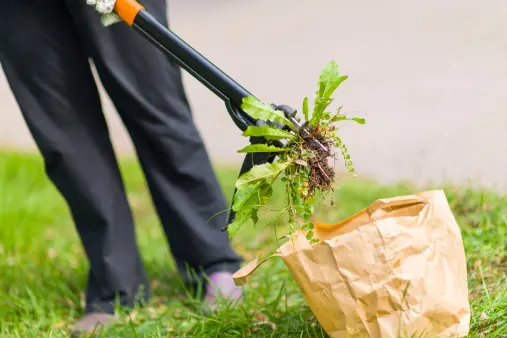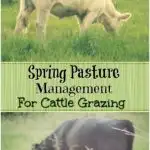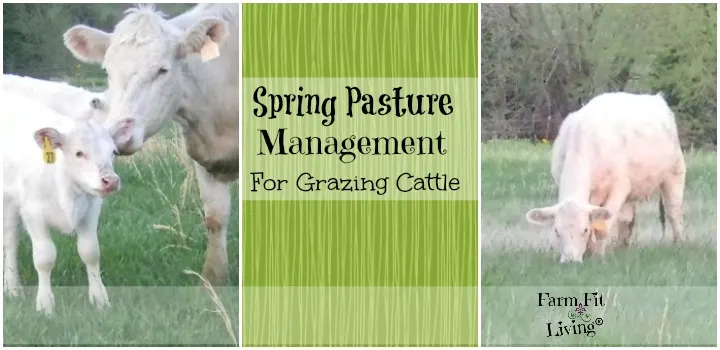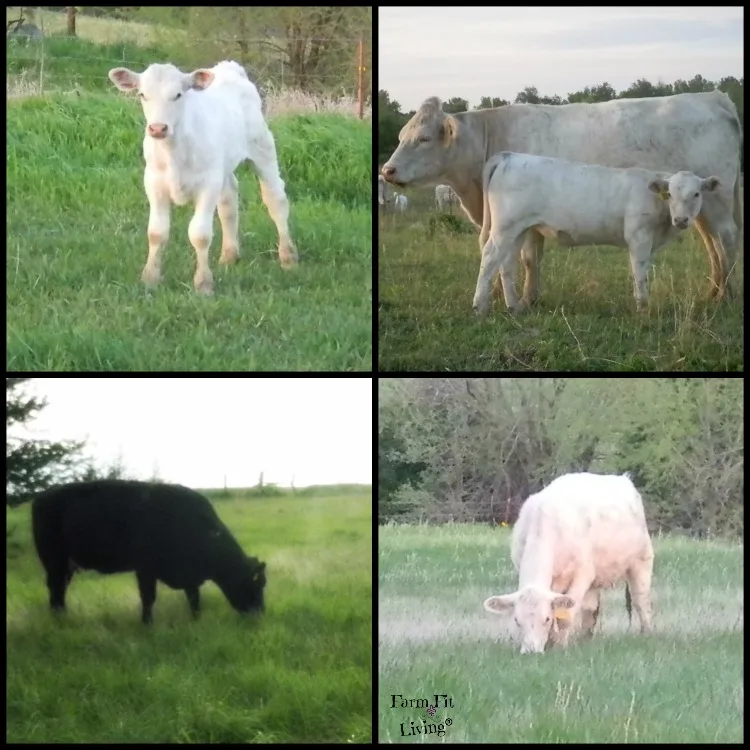As the snow melts and weather warms up, it’s time to start thinking about spring pasture management to prepare for the long grazing season.
Spring pasture management and getting pastures ready for spring grazing is an important task on the “to-do” list for spring. It’s always one of my favorite times of the year when the green sprouts are popping through the muddy ground. And you can see the cows on the other side of the fence just licking their chops to get to it.
But I hold off letting them out until May 1. And that waiting game is a STRUGGLE! They are chomping at the bit to be on the other side of that 3-strand super hot electric fence. I’m super excited to not have to feed hay anymore until winter comes around again.
So, why don’t I let the cows out until May 1? Well, I will explain that later one. Keep reading, my friend.
But keep this in mind: Grasses don’t just thrive on their own. They need to be managed correctly. Cattle are HARD on grasses…especially new sprigs of baby grass seedlings. Spring pasture management is the key to grazing season success long term. So, treat your grasses right when getting pastures ready for spring grazing.
In this post, I will be covering:
- Types of cool season grasses in pastures that work well for grazing.
- Caring for those grasses.
- The process of getting pasture grass ready for spring grazing.
- Types of fertilizer options for grasses.
- Weed control for spring pastures. Read about weed control for vegetable gardens here
So, let’s begin now by exploring what early spring grasses you might have in your pastures.
Read about pasture management tips for FALL grazing here
Listen to the Podcast Episode Here:
Cool Season Grasses
These are the earliest spring grasses that you’ll see popping up in spring pastures:
- Bromes (Smooth Brome)
- Canarygrass
- Kentucky Bluegrass
- Orchardgrass
- Red Top
- Ryegrass (Perennial and Annual)
- Tall Fescue
- Timothy Grass
Cool Season grasses thrive in the early spring under cooler temperatures. They are the first grasses you see popping up in your pasture. You’ll need to walk out into your pasture and identify what you have to really know.
What do these grasses look like?
I know what you’re thinking right now…”Mindy, all little seedlings of cool season grasses all look the same.” There are ways to identify grass seedlings and you need to know what they are for spring pasture management! Here are a couple of great resources you can refer to when identifying grasses:
- Penn State University
- Midwest Forage
- Book: Seed & Seedlings Identification
- Your Local Extension Office
It’s always a good idea to refer to your local resource. Take some samples of the grass seedlings to your local Extension Agent to be identified. Make sure to include roots as well!
What About Introducing New Grasses into your spring pasture?
Maybe you have a pasture that is all brome grass (my hand raising). Want to add in some rye or red top? Here are some things to keep in mind:
- What grasses grow well in your area? Check with local resources.
- Fast growing grasses? Again, you’ll need to do some further research using your local university and resources.
- Also, grasses do well according to soil type. You might want to soil test to see if your soil is lacking in nutrients.
- When to plant those new grasses into your pastures.
That last one is a biggie. When to plant new grasses for spring pasture management? If you’re reading this after December, it might be too late to reseed the pasture.
How to Reseed a Pasture for Spring Growth
Yes, after the snow flies is really too late to reseed cool season grasses. The best time to reseed is in late summer/early fall. September/October is a really great time to reseed cool season grasses. Here’s why:
- Seedlings will have proper germination rates at ideal soil temperatures. Read about how to take a soil temperature.
- They will receive some amazing moisture (hopefully) during the winter with the snow cover.
- And if you fertilize in fall and spring, they’ll get double the nutrients they need to take off in the early spring. Here are some organic fertilizer options
- Finally, seedlings planted in fall will have proper growing time compared to seedlings planted in the spring.
Read my step by step instructions for how to take a soil test.
Remember that you want the grass seedlings to be fairly tall before letting those cows out to graze them. Our rule of thumb is generally ankle bone high at least. Why?
- This height supports regrowth after grazed by cattle.
- Regrowth is important for long-term grazing through the spring season.
So, make plans to reseed those pastures in the summer. Spring is too late but hopefully, you’ll have enough good spring grasses with great nutrition out there until warm season grasses begin to grow. Your goal for spring grazing should always and forever be the most excellent nutrition for your cows.
Nutritional Needs of Beef Cattle on Pasture
Cattle nutrition needs to be kept in mind even when those cows are out on pasture. You might think grass fed is “healthier” but you still need to make sure your cows are getting what they need!
Nutritional needs of grass fed cattle include:
- Protein
- Energy
- Minerals
- Vitamins
And cattle can generally receive most of what they need through spring cool season grasses. The most highly nutritious grasses grow in the spring and contain a good amount of a cow’s nutritional needs.
However, we do supplement some high-mag mineral to make sure that our cows are getting their sufficient amount of trace minerals. Why? Because depending on location, certain soils lack certain trace minerals. Such as selenium.
Here is a really good article out of Canada that goes into the nutrient requirements of beef cattle on pasture. It explains certain nutrients needed by cows and you will be able to see just how spring grasses are a good source of these nutrients.
Nutrient Content of Spring Pastures
Cool season grasses that grow in the early spring contain some of the absolute best quality and nutrition available for cattle of all types and kinds. As I’ve mentioned before, cows can really perform well on just grass with a little bit of extra minerals in the spring.
According to this study from Penn State, pasture nutritional quality highly depends upon the maturity of the grass when grazed. This is one of the major reasons that we wait until May 1 to let our cows onto spring pastures.
We want the grass to be ready for the cows. And while spring grasses are of great quality and mature on time, some years aren’t so great. Spring pasture quality and growth depends on these factors:
- Geographic Location
- Environmental Conditions (plenty of moisture and warm temperatures)
- Types of grasses you have in your pastures
- Grazing Management through the year.
Let me be honest here: Cattle destroy grasses. Let’s discuss next just how cattle graze spring grasses and why they are so hard on them.
How Cows Graze
So, how do those cows graze? Here’s the step by step process:
- Long strong tongue wraps around a clump of grass.
- Tongue pulls grasses in between the teeth on the lower jaw and pad on the upper jaw.
- Then, the grass is cut away when the cow swings her head.
Now, keep in mind that cows can comfortably eat when the grass is about 6 inches tall. And eating any closer than 2 inches from the soil is difficult for them.
Furthermore, according to a paper from Oregon State University, cows can take about 80 bites per minute, 8 hours per day with about 12 hours for rumination. This equals more than 130 pounds of food per day!
So, cattle are really hard on young spring grass seedlings:
- Trampling
- Pugging (Aerating)
- Fouling (Pooping)
Yet, another reason why we hold our cows off spring pastures until May.
When to Fertilize Pasture Grass for Spring Growth
After you know what nutrients your soils need to grow amazing cool season grasses, you can decide what fertilizer you want to apply. Here are a few options for fertilizer:
- Liquid fertilizer for pastures
- Livestock Fertilizer
- Pellet Fertilizer
Soil tests can tell you most everything you need to know about what your soil is lacking. But, you’ll see it in how your grasses are growing (or not growing). I can share with you our fertilization schedule, but remember that your location is different than mine. So, be sure to check with your local resources.
- First of all, we collect manure from all our animals and apply it throughout our pastures, hay ground, garden and even our yard!
The livestock manure provides a good quality phosphorus the most soils lack.
- Then, in the late winter/early spring, we apply a pellet nitrogen fertilizer onto our pasture and hay ground. Try to do this before a good rainfall is to occur so the fertilizer will soak into the soil. Many producers also will apply this fertilizer in the Fall and some will even apply both times!
All-in-all, it’s all about following with what your soil test recommends. If you see a problem with growing pasture grasses in a certain spot, you can apply fertilizer. But, just applying it may not be enough for that spot. A soil test would tell you exactly what and how much nutrient to apply!
So, soil is important for growing quality grasses for grazing. And when your grasses grow well, you can rest assured that there will be plenty of food for your cows if you stock the pastures correctly.
Stocking Rate for Cattle in Spring Pastures
So, this is a really broad section because every place, every pasture, every paddock and pasture is different.
Yet, according to NRCS, there is a rule of thumb:
- 1.5 to 2 acres per cow/calf pair for 12 months.
- So, for example, 11 cows on 20 acres is 1.8 acres per cow.
Again, this is very highly variable. There are other important factors to look at to determine stocking rate:
- Check with local resources to determine average stocking rate per area.
- Amount of rain fall.
- How much fecal would be excreted onto the pasture with this amount of stock.
- What grasses are growing in this particular pasture.
Finally, weed control in the spring is super-d-duper important. Let’s talk about why.

Controlling Weeds for Spring Pasture Management
Again with those weeds! Ugly blemishes in the midst of your beautiful sprigs of spring green grass seedlings.
Spring is one of the best times for control (late fall is the other). You want to control weeds before they mature. So, when they are in the rosette stage or seedlings. Your choice on how to control those weeds. Here are some options:
- Chemically: Identify weeds early and spray them before cows are on pasture.
- Mechanically: Manually dig them and dispose of them properly.
- Biologically: Multispecies grazing with sheep & goats. Read how I do it.
If you don’t control weeds, they will control your pasture. They will overtake the grasses and cows will have less food to eat. A clean pasture is always not only pretty, but pretty efficient!
And it’s all about timing. Just like when letting those cows out to graze.
Finally, When Grasses are Ready for Cows to Graze
So, when are grasses ready for cattle to graze them? Well, I’ve mentioned maturity. I’ve mentioned height. And I’ve mentioned safety of the grasses.
Because the goal is not only nutrition eventual regrowth of the grasses for a longer grazing season. The grass needs to be harvested by the cows at the proper length as well as protected from trampling and fecal density. So, knowing that peak time of grass maturity is ideal.
And that peak time may be different in your area, but here in Northeast Kansas, we like to wait until at least May 1 to release our cows onto spring grasses. By then, the grasses are at least 4-5 inches tall, making it safe and ideal for cows to tear them away from the ground.
Now, you know how to properly prepare and maintain your spring pastures for optimum cool season grass management. And it’s almost time to let those cows out!
Now, Your Pastures Are Ready
And the cows are ready, too. So before you let them out, you’ll need to check fences, apply watering tubs and mineral feeders. Make sure the pasture is safe for them to be out there through the grazing season.
I have covered many things to think about, haven’t I? But I hope you understand the process of caring for the grasses. If you want to be profitable and successful with grazing livestock, you have to be able to feed them right.
And it all starts with the grass itself. Make sure that grass is fed, tall, mature and safe. Give it a chance before you let those cows out. And you’ll find out that just a little bit of a head start and some good spring pasture management strategies will go a long way.
I’d love to find out what cool season grasses in pastures are in your area! Also, how do you spend time getting pastures ready for spring grazing? Leave it in the comments!







5 Big Issues with Farming You Might Be Facing
Monday 23rd of April 2018
[…] For further reading on Spring Pasture Management, Go Here […]
Why Is That Cow Eating Her Placenta? | Farm Fit Living
Wednesday 4th of April 2018
[…] For more info on managing Spring Pastures, Go Here. […]